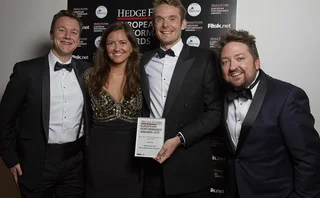
Taking the risk out of pension planning
David Walker spoke to Dawid Konotey-Ahulu and Robert Gardner, founders of Redington Partners, to find out how they aim to do just that ..
Redington Partners is a pension consultancy with a difference. As its co-founders Dawid Konotey-Ahulu and Robert Gardner explain, the founders of the London-headquartered firm, with around $120bn liabilities under consulting, have their roots firmly in risk management.
"Myself and (co-founder) Robert Gardner spent several years in investment banking and risk management is our background," he says. Konotey-Ahulu spent six years as a managing director in the pensions and insurance strategic solutions division of Merrill Lynch, after 10 years at NatWest Capital Markets, while Gardner spent four years at Deutsche Bank before moving to Merrill Lynch in 2003.
Konotey-Ahulu ran the ALM group at Merrill Lynch. Casting one's eye around the investment banks today, most of the large firms now have ALM operations, however it was Merrill Lynch's group under Konotey-Ahulu that performed what is believed to have been the first liability-driven investment solution, for Friends Provident's pension scheme, in 2003.
"They wanted to quantify and fully hedge their interest rate and inflation risk," explains Konotey-Ahulu.
"It was the first time a pension scheme had analysed risk in a way that the banking world analysed its risk. Friends Provident wanted to hedge out their risk, whilst simultaneously keeping a large equity allocation. Up until that point if you wanted to hedge risk you had to sacrifice equities and buy bonds, you could not have both.
"But very few pension schemes back then had anticipated the impact of interest rates and inflation risk. Most pension schemes and their advisors took the view that the main investment risk was equities." Equity volatility, high back in 2002, was viewed by many as the main exposure, "liabilities were regarded as a secondary risk. People did not think inflation would rise or that the real yield would fall much further, impacting the liabilities, nor that the deficit would go onto the corporate balance sheet."
Since then and since Redington was subsequently founded in 2006, ALM has become an integral part of many pension schemes' attempts to plug shortfalls on both sides of the Atlantic and further afield, and Konotey-Ahulu and Gardner still provide such solutions for pension plans. Arguably reflecting Redington's focus on risk and risk analysis is the fact that around half its 26 employees are quantitative analysts. Redington advises not just on funds of hedge funds in the manner of its peer group, but more broadly across a wide range of asset classes, and it does so to clients in Europe, the UK and North America.
Konotey-Ahulu says he and Gardner set Redington up for two primary reasons. The first factor he cites as impetus is a conflict - whether perceived or actual - in clients' eyes of a consulting/advice type service being offered out of an investment bank, which also then provides a suite of products to solve the problem.
(It is a problem that persists, but which has arguably been compounded by other pension consultants launching investment products.)
"The second reason for forming Redington was that we were showing clients the products of one bank and while they were very good products, there was no diversification. Clients wanted open architecture and the best of the best products the market could provide," Konotey-Ahulu says.
"Clients rightly wanted to see 'best in class' solutions across the board and it was difficult to offer that if they were only seeing one house's product."
"Now we operate our 'sub 10 second rule'. Imagine you are planning to compete in the Men's 100m in Beijing in next summer's Olympics. If you want to have any chance of being on the podium you will have to run sub ten seconds. So even though 10.01 seconds is very quick relative to the average runner, it's just not quick enough to come in the top three. That's how we look at product. We look at what the capital markets or asset management industry has to offer and then we select the sub-10 second product that works for the client. It's a very simple but powerful way of accessing the very best product".
Gardner says there was and still is a "real dearth of capital markets understanding in the space and it is clear what is needed in investment management for pension schemes is 'fusion consulting'." This is the crux of Redington's offering.
"We are bringing a lot of capital markets and investment banking experience and expertise, and blending that with investment consulting, and actuarial advice to give clients what they need. That is effective tools for risk management combined with understanding exactly what it is they need from a pension scheme perspective."
Gardner says that as Redington analyses pensions schemes' existing portfolios, and architects new allocations and strategies where necessary, the firm is especially mindful of helping the trustees understand what risks they are running presently - interest rate, inflation, equity, credit, property and others - and how to improve the risk/return profile "while thinking about correlations and adopting a reasonable time horizon".
"It's a relatively new concept looking at risk correlation across the pension scheme, but it's one that banks and insurance companies are quite familiar with." This he attributes to capital adequacy requirements, for example under Basel II, and financial firms having to be ever mindful of the profile and type of risk they're running in order to calculate the capital they must set aside.
"You find most insurance companies spend much of their time working out how they can better manage risk: it's the balance of minimising risk without sacrificing returns. We are bringing the same technology to our clients." Interestingly in this, Redington may sit quite close in its mindset to that of hedge fund managers.
Gardner notes, as do many of the more established funds of hedge funds serving the institutional client base, that no two pension schemes are the same in what they want. His words are perhaps as instructive to FoHFs looking to be recommended by consultants such as Redington, as they are to pensions schemes trustees themselves.
"Different pension schemes can be affected very differently by regulations. An investment bank will face huge capital implications that have to be dealt with in relation to its pension scheme and a UK insurance firm will face different risk management issues to a High Street retailer. Each will also have a different employer covenant, depending on the strength of the sponsor. Depending on whether you're talking about a (FTSE 100 company) or one at the other end of the spectrum, that covenant determines what the risk/return profile is likely to look like. A healthy and strong sponsor may be less concerned about taking risks, because in extremis they would have several million pounds or euros or dollars to commit."
Konotey-Ahulu does not go as far to suggest that the decision-making process at pension schemes is completely integrated with a full-scale corporate finance analysis of a firm's balance sheet, or that every pound the pension scheme spends is determined by the corporation's chief financial officer.
Corporate dedication
Nevertheless, since pension surpluses and shortfalls have had to appear on the balance sheets of UK pension scheme sponsors since 2003, the interaction between trustee and CFO cannot be ignored - and so Redington has one staff member dedicated to the corporate finance function. "It's our job to understand the pension scheme but also the corporation," Konotey-Ahulu says.
Consequently, Redington may ask of firms about their capex plans, their funding commitments to the pension, its creditworthiness as well as EBITDA in isolation and compared to its peers. "We will also look at the credit default swap market to understand what the market is thinking. If the credit spread blows out, that may be relevant information not yet reflected in the stock price.
"We are investment bankers at heart and the corporate finance analysis is something investment banks do very well, and it's not what investment consultants may be geared up to understand. A traditional consultant does not typically have a background of understanding and using the same risk measurement techniques that an investment bank would have, using for example VaR or conditional tail expectation. These are tools investment banks use regularly, and most consultants are now having to get to grips with.
"You're seeing the meeting of two quite different disciplines as traditional investment and actuarial consulting is quite different to investment banking. They are now converging in this space together with asset management."
Redington's approach is to conduct what Gardner calls a "financial MRI scan of the pension" and analysis of the sponsor, in order to devise a risk budget. A strategy encompassing all asset classes can then be tailor made, and Redington will help the pension scheme implement this.
"We do not just do the 'grand vista', we do everything right the way down to exactly what you want to buy, including getting the very best product manufacturers for the job." Redington will be involved to varying degrees in the selection of managers to get the job done - for example, if an investment bank is involved, possibly for hedging derivatives in an ALM package, Konotey-Ahulu and Gardner know all 15 well "so we know whom to go to and how much you should pay for the products you need".
It has three employees dedicated to fund research, Gardner says, but may work alongside other firms in aspects of the selection process.
As well as finding FoHF managers to select from, Redington can also assist clients in combining single hedge fund managers. "We have state-of-the-art systems that can help us do this, and the overiding question is always 'What is the risk I am taking for the return I am getting?'."
On the one hand, apropos hedge funds Redington sees more pension schemes beginning to look at direct investment, although Gardner stresses this is still embryonic, and on the other single hedge funds that have plateaued with FoHF money and are looking at pension schemes as the next step in increasing AuM. If you are in the latter category, Gardner says expect to be asked by Redington about risk management, and "returns, especially how you have fared over the past four or five months. We want to understand why returns are as they are and if a hedge fund or FoHF provides an explanation, we will stress it to see if it's borne out in practice."
Redington makes extensive use of stress testing and, while Konotey-Ahulu says these past few months saw "a whole new set of unprecedented events including a crisis in the Libor markets", he says that being able to conduct deterministic scenario analysis "means you can anticipate those events that are only supposed to happen once every 150 years and ask what happens if you get that five days in a row. You can't guarantee the new investment strategy you put in place will not lose money, but you can meaningfully compare it with the existing strategy and come up with something that is much more robust and likely to deliver."
Taking flight
Konotey-Ahulu employs the analogy of an airborne aircraft to explain how Redington sets the right direction for clients' portfolios - and then ensures in flight that the course is right.
"If you're a 747 captain flying from London to New York you come up with a flight plan to set your path and in flight you're and constantly checking and making slight adjustments to make sure you actually touch down at JFK, not Toronto or Chicago. The pension scheme is undertaking a long journey. There may be crosswinds on the way and you have to check where you are against where you should be."
Trustees do not need to be bombarded daily with every granular individual detail of their portfolio risk analysis but they do need a dashboard with basic key information - similar to the back-seat screen for passengers, versus the menagerie of lights in the cockpit - Konotey-Ahulu says.
"They need to know how fast they're travelling, their current position, how long they've been travelling for, the windspeed and when they're scheduled to arrive." And, of course, if JFK is still where you thought it was.
In explaining the analogy Konotey-Ahulu says, "You should be looking at risk, return, scheme funding trajectory (for example, 'In 10 years' time I want to be fully funded to buy-out level'); what's happening in the markets; what's changed over the last month ('Are there crosswinds I did not have three months ago or do I suddenyl have a lightning storm to negotiate?'); my risk of disaster, have key cross-market correlations changed and has volatility increased or decreased?"
Checking the detail
Konotey-Ahulu emphasises the need to check navigation instruments regularly - no less than monthly - and notes that some consultants traditionally make some checks only every three years. However, he adds, while having a long-term strategy (flying to New York) will not necessarily entail excessive changes to tactics (adjusting trajectory or height once airborne), and clear trigger parameters should be set so that those in control can adjust certain instruments and the path. "If there's a crosswind for equities and the risk to return is outside the strategy guidelines you have given, you may have to reduce your allocation. The point is that you have a clearly thought-out plan that's not made on the hop. It's a framework within which you're in control and you're taking exactly the amount of risk you want to take. As little as possible is left to chance." Consulting in 2008 is about understanding that there is a destination to be reached in years to come, Konotey-Ahulu says, and this both takes trustees beyond simply considering a list of fund products, and helps the sponsor to agree upon a planned course of action. As more stakeholders focus on pension shortfalls, this approach can also assist unions, government sponsors, private equity houses and others involved in a firm's future a clear framework for making decisions, Konotey-Ahulu notes.
A pension scheme without a robust investment strategy in 2007 can also be "hugely damaging" to corporate decision-making as well, of course, with Konotey-Ahulu citing the derailing of various M&A transactions during 2007. "It may not be because the pension is in a particularly bad shape but rather because the various parties involved simply cannot come to a mutually agreeable solution."
To this end, and with experience stretching back to Friends Provident Pension Scheme in 2003, Redington is adept at educating (and negotiating with) a wide range of interested parties, from building blocks of the basic investment strategy through to negotiating the correct price of a hybrid equity index option or a 50 year inflation swap with an investment bank. Konotey-Ahulu qualified as a lawyer "so I occasionally wade into ISDA documention if that's what is required", and so on. And as pension gaps worry trustees and hit corporate balance sheets Konotey-Ahulu says Redington's dedicated education department is "pushing against open doors" in initiating such conversations. "Trustees are very keen to learn."
"And in the end if what you're coming up with is the most cost efficient and effective way of reducing risk and maximising return over a sensible time frame with the ultimate view of getting the pension scheme fully funded every stakeholder wants that."
TO BUY OR NOT TO BUY FUNDS OF HEDGE FUNDS?
Dawid Konotey-Ahulu notes that, while some pension clients will say they have ruled out investing in hedge funds, Redington's constant monitoring of a portfolio's position in flight and prevailing conditions may make an allocation to alternatives a worthwhile proposition, regardless of what has been said in the past.
"You may see a client who is 65% in equities, 20% in bonds, 10% in property and 5% in cash, and we may say it's worth hedging out your interest rate and inflation risk, not by buying more bonds but by using derivatives, which has a dramatic impact on your risk, and sell down some of your equities.
"You may reduce your allocation to 45% in equities and with that divested 20% allocate it across a number of diverse alternatives such as hedge funds, private equity, commodities and structured products.
"If you're considering a 5% allocation to FoHFs, that is very different to saying in isolation, 'What do you think about hedge funds?' It's an integrated discussion about your overall asset allocation and risk profile. We will say to clients, many hedge funds are run by some of the best investors in the business trying to make as much money for their clients as they can in the smartest way possible and they have proven track records, but you allocate to them strictly in the context of what you already own and within a clearly defined risk budget.
"We have built a consulting firm from the ground up as we think it should look; we are very integrated. We provide an overview of what we do as a whole firm geared toward solving the risk/return issue."
Only users who have a paid subscription or are part of a corporate subscription are able to print or copy content.
To access these options, along with all other subscription benefits, please contact info@risk.net or view our subscription options here: http://subscriptions.risk.net/subscribe
You are currently unable to print this content. Please contact info@risk.net to find out more.
You are currently unable to copy this content. Please contact info@risk.net to find out more.
Copyright Infopro Digital Limited. All rights reserved.
As outlined in our terms and conditions, https://www.infopro-digital.com/terms-and-conditions/subscriptions/ (point 2.4), printing is limited to a single copy.
If you would like to purchase additional rights please email info@risk.net
Copyright Infopro Digital Limited. All rights reserved.
You may share this content using our article tools. As outlined in our terms and conditions, https://www.infopro-digital.com/terms-and-conditions/subscriptions/ (clause 2.4), an Authorised User may only make one copy of the materials for their own personal use. You must also comply with the restrictions in clause 2.5.
If you would like to purchase additional rights please email info@risk.net
More on Hedge funds
JP Morgan warns hedge funds to expect intraday margin calls
US bank may demand variation margin ‘up to seven’ times a day after Archegos default
Alternative markets give edge to Florin Court strategy
By concentrating on exotic and alternative markets, Florin Court Capital Fund has sidestepped overcrowding and correlation to the main trend following commodity trading advisers, offering investors a diversified alternative to the standard systemic macro…
Global macro views combine with quantitative models to produce consistent returns
The team behind River and Mercantile Group’s global macro strategy team operates under two key principles: that macro is the most important aspect of any investment decision and that decision-making should incorporate both systematic and discretionary…
On the offensive – Seeking a new edge, buy-side invests in portfolio and risk analytics
A fast-moving, headstrong hedge fund – hit by rare losses after a black swan event touched on an overweight country exposure – ponders adding fresh quantitative expertise. Much to traders’ chagrin, the chief investment officer and chief operating officer…
Esma backtracks on account segregation
Status quo protected for rehypothecation of collateral in tri-party, securities lending and prime brokerage
Redemptions focused within strategies suffering losses in 2016
Redemptions focused within strategies suffering losses in 2016
Hedge fund redemptions a dismal end to a bad year
Managed futures funds saw big inflows in 2016, but left investors disappointed
Larger funds are net losers as outflows continue
Managed futures funds have seen biggest redemptions for three years






